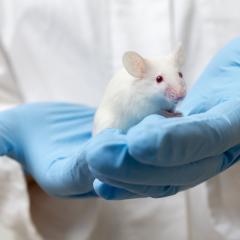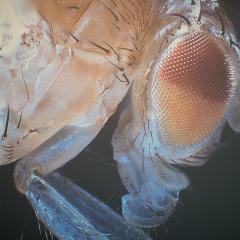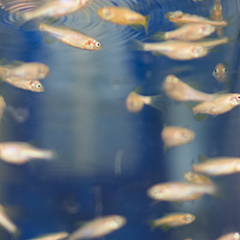Animal Models

We're here to support your research with our animal models expertise.
Several labs across our Center work with rodent, zebrafish, and fly models to unravel the mysteries of the brain. Lutgarde Serneels, our Rodent Models Expert, shares more about what facilities and expertise she provides research groups: "An expanding toolbox of genetic technology, together with the biological conservation, makes the mouse an important model system to decipher mechanisms underlying biological and disease processes. We provide help with rodent husbandry, access to conventional and state-of-the art dedicated SPF chimeric animal facilities, know how, and help with genetic design and mouse embryo services including micro-injections to engineer the mouse genome."
Rodent Model Services
The expertise and services at our Rodent Facilities are available for research use.
To initiate a project, contact Lutgarde Serneels (lutgarde.serneels@kuleuven.vib.be) and explain your request. After reviewing the request to determine feasibility, we will provide a service agreement, including our prices.
For more information about starting experiments involving laboratory animals, go to LAC.
You can also make use of the expertise present at mINT.
Please acknowledge the Rodent Expertise Unit in the acknowledgment section if you publish results using the mice generated with our help. It is essential for our funding and success.
SOPF/semi-SPF facility: Immunodeficient mice
SOPF/semi-SPF facility: Immunodeficient mice
-
Housing in SOPF and semi-SPF conditions
-
Xenografts in neonates and adults
-
Stereotactic injections
-
2D photon imaging (2 colours, 30Hz imaging single plane 4-6Hz volumetric imaging across 250 µm, max FOV 1.5x1 mm)
-
Behavioral setups for training on visual psychophysical tasks
-
A2 core (BSL2 - viral vectors and proteopathic seeds)
Conventional Facilities
Conventional Facilities
-
Conventional housing of mice/rats/hamsters (IVC cages)
-
Hibernation: we work with hamsters, reference Patriks research
-
Stereotactic injections
-
In utero injections
-
In utero electroporation
-
Nikon SMZ25 fluorescence dissecting microscope
-
Perfusion lab
-
Behavior and physiology labs
Behaviour Assays
Behaviour Assays
|
Domain |
Tests |
|
Treadmill, Rotarod, Grip strength, Rotating hanging wire, Balance, DVC smart cages
|
|
Cold Hot Plate, Thermal Gradient Test, Tail Flick Test
|
|
Electronic and classic Van Frey filaments |
|
Dynamic Weigh Bearing |
|
5. Anxiety and Locomotion |
Open Field Test, Light Dark Box, Elevated T Maze
|
|
Novel Object Recognition, Barnes Maze
|
|
Spotting test - urodynamics; Cytometry (Labscope, micro-fluoroscopy for small animal-based x-ray) - urodynamics; Implantable telemetry– Heart Rate; Blood Pressure; Body Core Temperature; Activity and Electromyography; Non-Invasive Blood Pressure – Blood Pressure and Heart Rate; PeriCam (LSCI) – Laser speckle contrast imaging monitoring cardiovascular perfusion
|
|
Lickometer, metabolic metal cages |
Genome Engineering and Reproductive Techniques
Genome Engineering and Reproductive Techniques
We provide mouse embryo services, including micro-injections to engineer the mouse genome
We perform embryo isolation, microinjection as well as transfer into foster females. For embryos microinjected with CRISPR-Cas9 reagents, we usually achieve success rates of about 80% for sequence deletions and of about 15% for sequence replacements by homologous recombination. In all cases, the researchers provide the DNA constructs, gRNAs, RNP’s or ES cells. Our staff performs all microinjections and surgical procedures. We deliver founders or chimeras for further crossing.
Zygote injection
DNA, RNA, Proteins, RNP’s are microinjected into 50-100 fertilized single-cell (or two-cell embryos), which is generally enough to yield 10-20 live births. Injected embryos are then surgically transferred into the oviduct of pseudo-pregnant females. Pups are typically born 19 days after transfer. Pregnant females are followed closely and foster mothers are available if problems occur. Occasionally, litters are lost due to cannibalism. If litters are lost, additional injections can be scheduled immediately.
The technology of CRISPR/Cas9 is a new and fast method for generating mice with a mutation, deletion or insertion in a gene at a defined position within the genome. For CRISPR/Cas9, the desired Cas9 protein, sgRNAs and if required DNA or ssDNA template will be injected into the pronucleus of zygotes or two-cell embryos. For the generation of KO mutations, we are using an electroporation method. We have successfully used this technology to create the mutations directly in single-cell fertilized embryos:
- KO mutations
- Single point mutation KI
- Insertion of epitope tags to create tagged fusion protein
- New mutations in established mutant mouse lines
Blastocyst injection
Investigator-provided ES cells are injected into the cavity of an expanded blastocyst stage embryo (CD1 or C57Bl6) and injected embryos are surgically transferred into the uterus of recipient females.
Not all ES cell clones will result in chimeric mice and not all chimeric mice will transmit the mutated allele through the germline to the next generation. The ability to generate germline transmitting chimeras is dependent on the pluripotent state of ES cells. For these reasons, we cannot guarantee that microinjections of stem cells will result in the generation of chimeric mice or that chimeric animals will be germline competent.
We have successfully generated germline competent chimeras from investigator-supplied targeted clones. We offer to inject the same ES cell clone in blastocyst stage embryos on two consecutive days to ensure enough surviving pups.
We also offer aggregation of ES cells with morula stage embryos and tetraploid complementation assays.
For full-service packages and ES stem cell work we are collaborating with the MutaMouse genome engineering unit.
Cryopreservation
Cryopreservation
We offer both cryopreservation of sperm and embryos in liquid nitrogen. This helps to save resources when strains are not actively used for research, prevents genetic drift and excludes loss of colonies in case of a disaster (infections, fire...). When required, we use in vitro fertilization and embryo transfer to revitalize the frozen samples. We also accept frozen sperm and embryos from external sources. The same in vitro techniques are used for hygienic rederivation of mouse strains to import them in SPF facilities.
Cryopreservation is a safe method for preserving healthy pre-implantation embryos or sperm that can be easily recovered to revitalize the strain at any time.
There are many reasons to consider cryopreservation of your mouse lines:
- Insurance against loss of colonies in the event of calamity.
- They are a back-up in case of reproductive failure within a colony.
- Results in significant long-term cost savings and mouse room space.
- It helps to control genetic drift
- A genetic resource for refreshing mouse lines.
- Cryopreserved stocks can be shipped to or from collaborators worldwide
Sperm cryopreservation is a simple, highly cost-effective method for cryopreservation. Although only half of the genome is preserved as frozen sperm, cryopreservation of sperm is significantly more cost-effective and faster as compared to embryo cryopreservation. This technique works well with common backgrounds like C57Bl6, CD1. We are storing more than 250 strains since 2011. The recovery of sperm from cryopreservation requires an In Vitro Fertilization (IVF) procedure. Our recovery rate after IVF is 94%.
Embryo cryopreservation is the method for preserving mouse lines with a complex genetic background. However, due to inherent technical inefficiencies associated with the procedure and strain differences, it is more costly than sperm freezing. Some strains have low fertilization capacity and do not yield sufficient numbers of fertilized embryos. This could partially overcome by the use of IVF. Our recovery rate is 90%.
We are storing the samples divided over two LN2 containers located at two different buildings on campus.
Revitalization and rederivation of mouse strains
Revitalization and rederivation of mouse strains
An important variable that affects the results of mouse studies is the health status of the animals. Pathogen burdens may confound observations and obscure underlying mechanisms. Embryo transfer is the golden standard to obtain specific pathogen-free mice.
Fresh embryos, embryos obtained by In Vitro Fertilization techniques or thawed embryos are subjected to extensive washing procedures and then surgically re-implanted into pathogen-free pseudo pregnant females. The resulting pups will be housed in the Q-zone and will be tested for the absence of pathogens at the age of 8 weeks before sending them to your colony.
The recovery of sperm from cryopreservation requires an IVF procedure. This procedure is typically performed using wildtype oocytes. If desired we can use female animals from an investigator's personal colony. Mouse strains can vary in their sensitivity to superovulation, which can result in low oocyte numbers.
The Mouse Expertise Unit collaborates with The Laboratory Animal Center for Caesarian rederivation. Depending on the initial health status of your strain, Caesarian rederivation is more cost-effective and faster as compared to embryo rederivation.
Take a Virtual Tour
Curious about our Animal Models facilities? Check out what we have available at the VIB-KU Leuven Center for Brain & Disease Research via our 360° virtual tour.
In the Spotlight

Stem-cell-derived human microglia transplanted in mouse brain to study human disease
Published in Nature Neuroscience
From the Bart De Strooper Lab

Astroglial Calcium Signaling Encodes Sleep Need in Drosophila
Published in Current Biology
From the Sha Liu Lab

HNRNPK alleviates RNA toxicity by counteracting DNA damage in C9orf72 ALS
Published in Acta Neuropathology
From the Ludo Van Den Bosch Lab
Why is animal research necessary?
With the advent of Human Models of disease, why do we continue to use animal models? Browse our resources to find out more.

VIB: the short version
VIB published a short article on the importance of animal methods in scientific research.

VIB: the long version
VIB published a document outlining the facts, laws, approach, and more on the use of animals in science.

KU Leuven Animal Research
Read more about the vision, legislation, ethics and welfare underpinning animal research at KU Leuven.

Do we still need animals?
We published a paper titled: Do we still need animals? Surveying the role of animal-free models in Alzheimer's and Parkinson's disease research.
